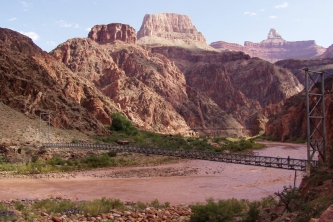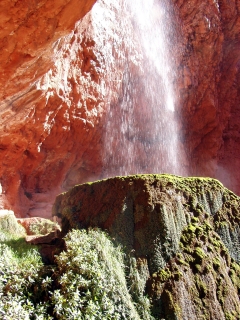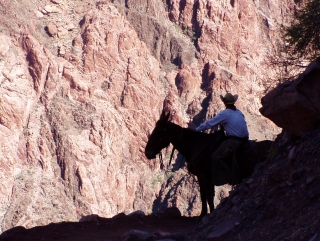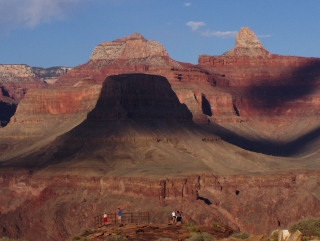NPS Website; Local Website
 WHAT IS IT?
WHAT IS IT?The guts of the Grand Canyon. The 277-mile long Colorado River, beginning in Lees Ferry, Arizona and ending at Lake Mead. Whether you whitewater raft in or hike or ride a mule down from the North Rim or South Rim, your experience is going to be much different than if you chose to stay on the Rims. The views, the Canyon’s colors and the River itself become a part of you. You are inside the Grand Canyon!
BEAUTY (10/10)
The rocks at the rim are 260 million years old. By the time you have reached the bottom, you have passed ten different exposed layers of geological history and have traveled back to rocks formed 1.7 billion years ago. You see the change; the multiple hues, the physical composition and the dramatic horizontal lines. Heady stuff. The ruggedness is strikingly beautiful.
The bottom is both a peaceful oasis and a still-furious river. Trees bloom, streams rush, temperatures soar and emerald nooks like Ribbon Falls enchant. It is a different world along the Canyon floor.
HISTORICAL INTEREST (8/10)
When we crossed the narrow swinging bridge across the Colorado the water was that famous brownish-red stew of swift moving trouble. The same color that John Wesley Powell saw when he raced down the River, the last mysterious and unmapped place in the continental United States. Dams have changed the River’s flow and demeanor and most of the time they have changed the color as well. Nowadays the Colorado is a more mundane clearish blue. We were lucky. Rainstorms had stirred up the murky bottom. We were transported into the past. Once we left the bridge we passed a 10,000 year-old ruin of an Indian habitation. Powell saw the same ruin in 1869, next to the same red raging River.
CROWDS (8/10)
There is a special feeling of camaraderie amongst those going to the bottom. Conversation start much easier, everyone is polite and smiles abound. You are all in this together. You are going up the same Canyon. We spoke to a couple the eve of our Canyon exit. We sat together at Plateau Point and watched the beginning of the sunset. They were both 75 years old, married to each other for 50 years and could not wait to get started on the hike out.
 EASE OF USE/ACCESS (1/5)
EASE OF USE/ACCESS (1/5)The most difficult access hurdle may not even be the Canyon, it could be getting your hands on a Grand Canyon Backcountry Permit. We never thought we would be able to get a permit. We were not willing to set a specific date and hope for a winning lottery ticket. 30,000 requests are made each year for permits, 13,000 are issued.
Little did we know that the Park Service holds out a few first-come, first-served permits every day. If you are flexible with your schedule, quickly get yourself on the waiting list and arrive at the backcountry office before 8 am your chances are good (at least in October). Everyone we talked to that got a permit ahead of time did not get the itinerary they requested. Getting a permit is a hit or miss prospect but it is not as hard as you might think.
From the North Rim, the only marked and maintained path is down the North Kaibab Trail. It is14 miles to the Colorado River and a descent of nearly 6,000 feet. And you have to go back up. Not too accessible.
There are two maintained paths and two other trails that lead from the South Rim down. The distances of the four trails vary but the descent to the River is going to be 5,000 feet. We hiked on both maintained paths, the South Kaibab Trail (down) and the Bright Angel Trail (up). We much preferred the Bright Angel Trail. Better views, more shade and not nearly as steep. Again, not too accessible.
The maintained paths going from the North Rim to the South Rim are collectively called the Grand Canyon Corridor. There are three campgrounds on the Corridor: Cottonwood, Bright Angel and Indian Garden. All three have toilets, emergency phones, potable water and Ranger Stations. Most of the hiking permit requests are for the Corridor. First-come, first-served trips are limited to three nights on the Corridor, ahead of time requests have no bounds. If you are willing to hike in the Threshold, Primitive or Wild Zones (Canyon hiking experience highly recommended in all three) securing a permit might be easier.
Getting to the North and South Rims is another story. See their separate reviews for more information.
 The boat option may not be as taxing to your legs, but the Colorado may well be the most treacherous white water in the world. We say take your chances with the mules. Most of the people we saw going down looked petrified. Spots on the both the boats and the mules book months even years in advance.
The boat option may not be as taxing to your legs, but the Colorado may well be the most treacherous white water in the world. We say take your chances with the mules. Most of the people we saw going down looked petrified. Spots on the both the boats and the mules book months even years in advance.Regardless of your choice, it is going to be fun.
CONCESSIONS/BOOKSTORE (2/5)
The mere fact that there is something at the bottom of the Grand Canyon is reason to celebrate. The Phantom Ranch canteen serves affordable meals, an array of candy bars and cans of beer. They also sell Phantom Ranch logo hats, shirts, patches, pins and more. Buy ‘em while you can, because as an added bonus they’re only for sale at the bottom. You will have proof for all your friends that you made it.
The Phantom Ranch, as well as a host of rest stations along the way down the maintained Grand Canyon Corridor, has water pumps dispensing potable H2O. You don’t have to carry days worth of heavy fluids on your back and a water purifier is unnecessary. Incredible stuff if you think about it. Check with a Ranger Station before your descent to make sure the water pipes are working.
COSTS (3/5)
Entry is $20 per vehicle, or free with the National Parks Pass.
Backcountry permits cost $10 per permit plus $5 per person per night camped below the rim. Our three-night stay cost a total of $40. Not bad for a four-day, three-night stay at the bottom of one of the seven natural wonders of the world.
Nights at the rustic Phantom Ranch, located nearby the Colorado are not expensive. Cabins cost up to $92 per night and a dorm room bed goes for $26. Not such a bad price when you consider you do not have to lug your tent and sleeping bag back up the Canyon.
On the other hand, mule rides down and up the Canyon can get pricey; they start at $130 per person. The full 277-mile, two-and-a-half week trip down the Colorado can get exorbitant, ranging anywhere from $2,800 to $4,500 per person. Both need to be booked well in advance.
RANGER/GUIDE TO TOURIST RATIO (4/5)
Rangers are posted in the backcountry. This is a first for us. Two plus one volunteer at Bright Angel (Phantom Ranch), two at Indian Garden and er none at Cottonwood. It may be a foolhardy thought, but along the Corridor you always feel that official help is nearby. At Bright Angel, the Rangers that come around and check your backcountry pass are extremely talkative, average about 10 minutes of conversation per campsite.
 TOURS/CLASSES (7/10)
TOURS/CLASSES (7/10)We were too tired to attend either, but there are two Ranger-led talks a day at Phantom Ranch. We repeat, two Ranger-led talks per day at the BOTTOM OF THE GRAND CANYON! Maybe they are really good, who knows. This rating is pure speculation.
The Grand Canyon Institute offers numerous fee-based backpacking trips/classes into the Canyon. If this sounds like your sort of thing, click on the link above for more info.
FUN (10/10)
Hiking the Grand Canyon has become Gab’s official answer to, “What is the best thing you’ve done on the trip?”
WOULD WE RECOMMEND? (10/10)
If you have the ability to hike out, do it. If you can afford the white water, do it. If you have nerves of steel, go down on a mule. The experience is out of this world. The October weather was perfect, the hike was spectacular and we easily got a permit. We had the time of our lives.
By the way, try not to go in the summer. The temperature at the bottom rises above 110 degrees. There is no way we would like to carry a pack in that weather.
TOTAL 63/80
www.usa-c2c.com
© 2004-06